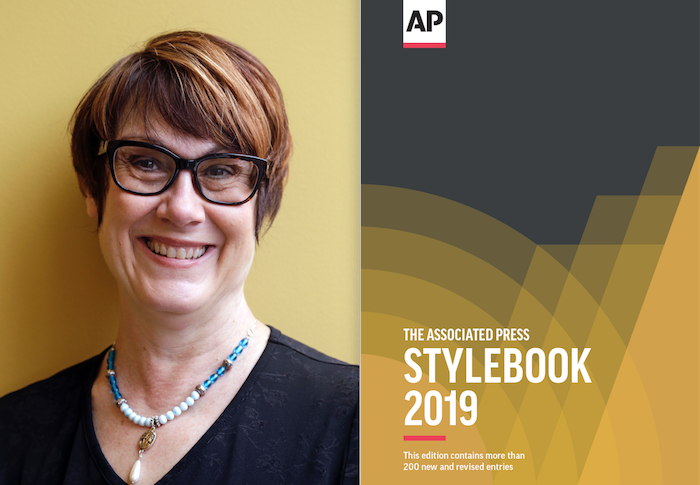House of Style: Q-and-A With the AP Stylebook’s Editor
By Amy Jacques
August 2019
Following the recent launch of the 2019 AP Stylebook, we spoke with Paula Froke, editor of the AP Stylebook and executive director of APME (Associated Press Media Editors), on the evolution of language and some of the book’s new updates for this year.
Froke, who is based in Philadelphia, has been the Stylebook’s lead editor since 2016 and a member of the Stylebook team since 2013; she has worked for The Associated Press in various editorial roles since 1984.
Here, she shares how and why changes are made.
How has social media (and content moving online) changed the idea of hard-and-fast style — with more people tweeting, texting, messaging, blogging?
Language and usage always have been evolving. That evolution probably has quickened and, certainly, it’s become more widely apparent in this online age. Style does indeed need to adapt more quickly than in the past. At the same time, though, we are careful not to adopt whatever latest “hot style thing” happens to come along. Of course, many of those texting, tweeting, messaging, blogging, etc., aren’t using any particular style.
We uphold the standard for a consistent style, though the specifics of some guidelines may change over time. Following proper style and using professional spelling, grammar and punctuation on social media help establish or reinforce your credibility on a platform where everyone has an equal right to share content, but not all of it is authoritative. One example of meeting the needs of social media: the guidance we added last year on how to “quote” emoji.
How do you decide on updates to the book, and how frequently do you amend the online version? Do you receive a lot of requests for additions and updates?
We get many requests for additions and updates from a variety of sources. Those include AP staff and members of the Stylebook team, our followers on social media, questions to Stylebook Online’s Ask the Editor feature or public suggestions link, and emails from members of the public and all sorts of groups and organizations. We assess which of those would be most likely to be of broad interest, and we put those on the list of proposals to tackle. We update Stylebook Online throughout the year.
What is the thought process at the AP behind making changes to longstanding style rules (like the change to writing out state names in datelines, for example)?
Any change involves a great deal of debate, discussion and, in many cases, consultations with others within the AP and outside the AP. The change to writing out state names was necessary because AP is a global news organization, and state abbreviations that are reasonably well known in the United States are not at all known by readers in other countries.
For efficiency, the AP had changed some procedures so stories weren’t being reedited several times for different audiences. That meant we needed one style that’s clear and understandable to all readers around the world. As with any style rule or guideline, organizations, writers and editors who aren’t with the AP can modify as needed for their own audiences.
The change from percent to % seems to have rattled some of the AP faithful. Has the Stylebook team ever considered walking back a style change for a follow-up edition?
Some love the change to the % symbol. Others aren’t so happy. Still others just need time to get used to it. (I’d include myself in that group.) We certainly have modified or changed some decisions and are always open to doing so.
What do people — especially in marketing, communications and public relations — say about why they decide to use AP style for their organizations? And do you see this specific audience (PR, marketing, comms) growing?
One of the most common reasons we hear communications professionals citing is that journalists use AP style, and they want journalists to cover their companies or clients. Writing in AP style means they’re speaking the language of the people they are pitching.
Since AP style’s roots are in guiding AP journalists, our rules are written with the idea of helping explain ideas to the kind of broad audience that might read a daily newspaper or online news site. That same clarity works well for many people in marketing and public relations.
We hear from numerous PR pros on Twitter and in Stylebook Online’s Ask the Editor. More than a few have told us they started their career as journalists using AP style in the newsroom.
What are some of the most commonly asked questions you receive (and/or most common mistakes you see in AP Style usage)?
Oxford comma is by far the most common question, or maybe that’s a complaint. It’s a matter of perspective.
By the way, some people oversimplify our guidance to say we never allow the Oxford or serial comma. The truth is, we don’t use it in a simple series but we do use it in a number of other instances where it adds clarity.
Do you have any tips or takeaways on how to familiarize yourself with the AP Stylebook, or best practices for usage and referencing items quickly?
That depends partly on how your brain works, and if you’re the kind of person who would benefit from reading the Stylebook cover to cover like a novel or if you’d do better following our Twitter feed to get a sense of the range of topics we cover.
We do offer AP Style Quizzes, which is a subscription to nearly 100 short multiple-choice quizzes on many topics. When you complete a quiz and click submit, you’ll see which answers you got right and wrong, along with the relevant style rule.
Do you ever feel any added pressure editing a book for professionals who edit for a living and help foster journalistic excellence?
We, too, are professionals who edit for a living and help foster journalistic excellence. That’s at the core of what we’ve always done at the AP. So the pressure is to uphold our own standards.
That said, we’re as human as everyone else and we’ve been known to make the occasional mistake. If you spot an error, please let us know! You may get a reward in return.
AP Style for PRSA Members
PRSA members receive a 20 percent discount on one single-user subscription to AP Stylebook Online each year. To claim your discount, visit apstylebook.com/PRSA. You will need your PRSA member ID.



